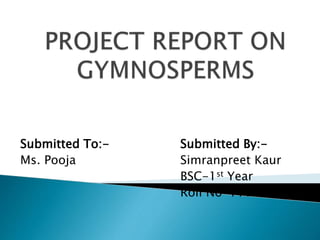
PROJECT REPORT ON gynosperm.pptx
- 1. Submitted To:- Submitted By:- Ms. Pooja Simranpreet Kaur BSC-1st Year Roll No-111
- 2. The word gymnosperrm is derived from the Greek words Gymnos = naked and sperm = seed. That means the plants with naked seeds The term was used in 300 B.C. by the Greek botanist Theophrastus for the group of plants with unprotected seeds. The gymnosperms have their ovules freely exposed and attached on open megasporophylls whereas the ovules in angiosperms are protected within the closed megasporophylls (carpel). Therefore, the gymnosperms are placed under distinct subdivision of spenuatophyta (phanerogams or seed bearing plants). Goebel described these plants as "phanerogams without ovary".
- 3. 1. Distribution and Habit 2. External Features 3. Internal Features 4.Reproduction
- 4. The living gymnosperms are widely distributed in the cold climates of the temperates as well as in the dry and arid conditions of the tropics. Some gymnosperms occur even in arctic zones. In India, they are mostly distributed in hilly areas. Very few gymnosperms, except sonic cycads. grow in plains of India. Living gymnosperms are mostly perennials, xerophytic. evergreen. arboreal and woody plants. They grow as woody trees, bushy shrubs or rarely as climbers (e.g., Gnetales). None of them are herbs or annuals.
- 5. The plant body is sporophyte and differentiated into root. stem and leaves. The gymnosperms include world's tallest tree--siquoia (the giant red wood), measuring 125 metres in height and 30 metres in girth. This tree is about 4.000 years old and found in wood Park of California. The smallest gymnosperm is Zamia pygmia, which has underground tuberous stem The plants possess tap root system formed from the radicle. In some cases the roots symbiotically associated with algae (e.g., coralloid roots of Cycas) or with fungus ( mycorrhizal roots of Pinus). The stem is usually erect and branched (unbranched in Cycads). In most of the species. woody. The superficial surface of star) shows the presence of characteristic leaf scars. Leaves may he monomorphic (i.e., of one kind) or dimorphic (i.e.. of two kinds). When dimorphic, the folliage leaves are evergreen, simple (Pinus), or compound (Cycas) and protected by a thick cuticle. The scale leaves arc minute and deciduous.
- 6. The roots have &arch or polyarch xylem in vascular cylinder. The secondary growth occurs. In stem the vascular bundles are conjoint, collatcral and open. They are arranged in ring. Secondary growth occurs by the activity of cambial ring formed by joining of fascicular cambia and interfascicular cambia. Annual rings are distinct inmost of gymnosperms. The vessels and wood fibres are absent in the xylem (except in Gnetales) and the companion cells are absent in phloem. In some gymnosperms, the wood is manoxylic (e.g. Cycas) whereas in others it is pycnoxylic (e.g. Pinus).
- 7. The plants are usually heterosporous, i.e., produce two different kinds of spores — the male microspores and the female megaspores. The spores are borne inside the sporangia. The microspores (= pollen grains) are borne inside the microsporangia (= pollen sacs) and the megaspores (= embryo sac cells) are borne inside the megasporangia (= ovules). The development of sporangia is eusporangiate type, i.e., the sporangium develops from group of initial cells originating from hypodermis. The microsporangia are borne on abaxial or lower surface of microsporophylls (= stamens) and the megasporangia are borne naked on megasporophylls (= carpels). The microsporangia may be arranged in definite groups called sori (Cycas) or their number may be reduced to two (Pinus). The microsporophylls are aggregated in the form of compact structures called male cones (= male flowers) and the megasporophylls are usually aggregated in the form of female cones (= female flowers). In some cases, the megasporophylls are foliar in nature and not aggregated in the form of cones (e.g., Cycas).
- 8. Earlier the members of gymnosperms were placed and classified among angiosperms. They were not grouped separately as gymnosperms. But Robert Brown (1827) separated them from angiosperms and placed under a distinct group due to presence of unprotected ovules in them. Since then a large number of classifications were proposed by various authors from time to time.
- 9. Gifford and Foster(1989)- divided gymnosperms into seven major taxa (or divisions) as under Division1. Progymnospermphyta Order I. Aneurophytales OrderII. Archaeopteridales Division 2. Pterdospermophyta Order I. Pterdospermales OrderII. Glossopteridales Order III. Caytonials Division 3. Cycadophyta Order I. Cycadales Division 4. Cycadeoidophyta Order I. Cycadeoidales Division 5. Ginkophyta Order I. Ginkgoales
- 10. Division 6. Coniferophyta Order I. Conferales Family- Pinaceae Family- Taxodiaceae Family- Cupressaceae Family- Araucariaceae Family- Podocarpaceae Family- Cephalotaxaceae Family- Taxaceae Order II. Voltziales Order III. Cordaitales Division7. Gnetpphyta Order I Ephedrales Order II. Gnetales Order III. Welwitschiales The classification followed in thi